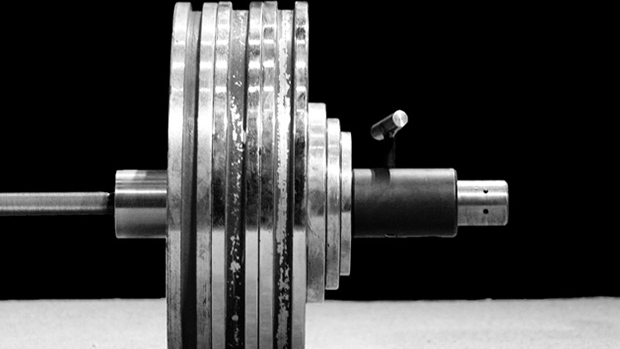After grinding through a lineup of taxing multiple-joint exercises, pushing sets to the limit, and trying to set PRs, ab work is the last thing lifters want to do. But don't leave the gym just yet.
Building and strengthening the abs can shore up weak links, prevent injury (particularly in the low back), lead to bigger lifts in the gym, and give you a carved-up mid-section.
Here are some no-nonsense ab and core exercises you'll love to hate:
Alternate between a weighted over-the-knees crunch variation and a reverse crunch. Start with five reps on everything and try to progress to 8 or 10 reps over time. Use a 10-15 pound kettlebell or dumbbell.
Finish with a 10 to 20-second hollow body hold and a 10 to 20-second RKC plank where you tense your body as hard as possible and drive your elbows back to your toes.
If you love the "burn," this should blow your hair back. I came up with this twelve years ago to keep my personal training clients (who were all about the abs) paying me. I ended up really liking it since you only need one or two rounds. If you hate ab work, at least it will be over quickly.
Here's a harder version which includes hollow body holds after every crunch/reverse crunch transition.
The serratus crunch is pretty effective on its own, but the ball increases the range of motion.
While this will fry your abs, you'll also benefit from the serratus activation, which is key for shoulder health and scapulae stability/mobility.
The chop makes it even harder as you change the length of the lever arm. Do 2-3 sets of 8-10 reps and you won't need any more than about 10-15 pounds.
This version isn't necessarily harder, just different.
- Do a rep and hold the contraction, protracting the shoulder blades hard up top for one second.
- Do the second rep and hold the contraction for two seconds.
- On the third rep, hold for three seconds.
- Continue until you're trashed and hit failure. Two sets should be plenty.
If you're not doing hollow body holds, now's a good time to start. Getting into and maintaining a posterior pelvic tilt will do wonders for your core strength, and I've found the variations of this exercise make my low back feel great.
If this is too demanding, a basic version where you hold a static position (hands behind the head or across the chest) without added load will do just fine.
The key is to keep your shoulder blades off the floor the entire time, and keep your low back pinned to the floor. Adjust the height of your legs as needed.
Adding a dynamic or weighted element will increase mind-muscle connection and force you to maintain the correct positioning. You won't need more than 10 pounds on each end. This is NOT a high-rep exercise.
This is a variation of the hollow body hold with the addition of spinal flexion and serratus activation. Don't rush these. Break it up slowly and methodically and transition smoothly.
This progresses the hollow body hold by adding an element of anti-lateral flexion and rotation into the mix. You won't need much added resistance. A very light mini-band or maybe one plate on a weight stack will be more than enough.
This is another hollow hold variation. You just add spinal flexion and serratus activation. Move slowly and methodically.
Rollout variations are hard enough on their own, but if you want to up the ante, try these in countdown fashion:
- Roll to point where you don't fall into spinal extension (if you feel it in your low back you're going too far) and come back in as normal.
- Do four reps. On the fourth rep, hold for four seconds in the fully extended position.
- Do three more normal reps and hold the third one for three seconds.
- Do two reps and a two-second hold.
- Do one rep with a one-second hold.
This turns out to be a 10-rep set. If you're not completely taxed by the last rep, continue doing normal reps until you are. You won't need more than one set of this. In the video, I made it harder by adding a slight decline.
You'll be hard pressed to find a better anti-rotation exercise. By kneeling, you cut off your base of support, making it more difficult. Keep your pelvis underneath you and squeeze the hell out of your glutes. Don't allow the weight to rotate you; keep your shoulders square.
Side planks are fine. That said, I'll rarely have clients do them since most people just butcher them (not getting their hip bone up high enough) or complain of shoulder pain.
This version eliminates both of those issues and you'll immediately feel your obliques firing if you make an effort to keep your torso up. Check out the video to see how you can add a dynamic element, add load, or manipulate the lever arm to make it harder.
Don't crush your ankle. You might want to wrap a bar pad or towel around the support for comfort.
Do 2-3 sets of 5-8 reps (unless otherwise instructed) of one of these exercises after every workout. Rotate through them throughout the week.
Pick an exercise from numbers one to four for your first workout, an exercise from numbers five to nine the next workout, and an exercise from numbers 10-11 the following workout. Try to progress in reps, load, or time over the course of weeks and months.
You might have a total of five minutes invested at the end of your workout. Keep the weekly total volume to no more than about 10-12 sets, broken up across whatever training split you're currently using.




